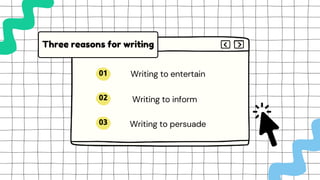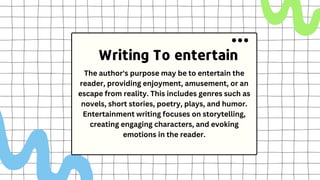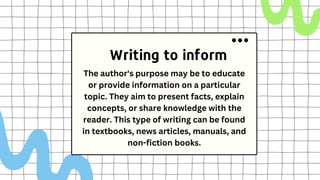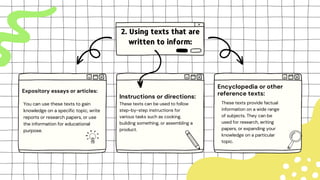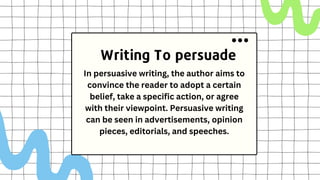POWERPOINT PRESENTATION ABOUT Author's purpose
- 1. TEAM 10
- 2. Writing to entertain Three reasons for writing Writing to inform Writing to persuade
- 3. The purpose of an author can vary depending on the context and the particular piece of writing. However, some common purposes include: 1. To inform. 2. To persuade. 3. To entertain. 4. To express. 5. To critique or analyze. 6. To document or record. 7. To provoke thought or reflection.
- 4. The author's purpose may be to entertain the reader, providing enjoyment, amusement, or an escape from reality. This includes genres such as novels, short stories, poetry, plays, and humor. Entertainment writing focuses on storytelling, creating engaging characters, and evoking emotions in the reader.
- 5. You can use poems to entertain by reciting them during special events or gatherings. They can be used to convey emotions, tell a story, or create a specific atmosphere poem : You can use songs to entertain by singing or playing an instrument. This can be done at parties, concerts, or even just for personal enjoyment songs You can use stories to entertain your readers or audience by reading them aloud, sharing them in written form, or performing them as a play. This can be done in various settings such as classrooms, libraries, or even at home. Stories
- 6. The author's purpose may be to educate or provide information on a particular topic. They aim to present facts, explain concepts, or share knowledge with the reader. This type of writing can be found in textbooks, news articles, manuals, and non-fiction books.
- 7. These texts can be used to follow step-by-step instructions for various tasks such as cooking, building something, or assembling a product. Instructions or directions: These texts provide factual information on a wide range of subjects. They can be used for research, writing papers, or expanding your knowledge on a particular topic. Encyclopedia or other reference texts: You can use these texts to gain knowledge on a specific topic, write reports or research papers, or use the information for educational purpose. Expository essays or articles:
- 8. These texts can be used to follow step-by-step instructions for various tasks such as cooking, building something, or assembling a product. Instructions or directions: These texts provide factual information on a wide range of subjects. They can be used for research, writing papers, or expanding your knowledge on a particular topic. Encyclopedia or other reference texts: You can use these texts to gain knowledge on a specific topic, write reports or research papers, or use the information for educational purpose. Expository essays or articles:
- 9. In persuasive writing, the author aims to convince the reader to adopt a certain belief, take a specific action, or agree with their viewpoint. Persuasive writing can be seen in advertisements, opinion pieces, editorials, and speeches.
- 10. These texts can be used when running for a position or giving a presentation to convince others to support a cause or candidate. They often include persuasive techniques such as emotional appeal, logical arguments, and effective communication. Campaign speeches You can use persuasive letters or notes to convince someone to take a particular action or change their opinion on a certain matter. This can be done in personal or professional contexts, such as business proposals, request letters, or personal appeals. Persuasive letters or notes: Advertisements You can use advertisements to persuade others to buy or try a product or service. This can be done by creating persuasive campaigns, designing eye-catching visuals, or using compelling language

